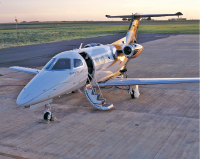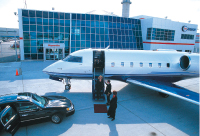
Features
Operations
Emerging New Markets: Canada’s business aviation reaping the benefits
Corporate aviation in Canada is still running in top gear and so far is showing positive signs of being able to avoid the fallout from the U.S. money crunch. That bodes well for the jobs in this country that are so closely tied to business aviation.
June 6, 2008 By Rob Seaman
 |
| The significant growth in demand for Bombardier business jets is coming from major emerging markets such as Russia and Asia. Pictured here is the Global Express XRS cabin. |
 |
| Embraer has been a welcome alternative to the corporate market. From the popular VLJ type through to intercontinental corporate airliner derivatives, we can expect to see the first Phenom 100 VLJs here by 2010. |

|
| The Skyservice fleet has grown by 30 managed aircraft in the last six years. |
Corporate aviation in Canada is still running in top gear and so far is showing positive signs of being able to avoid the fallout from the U.S. money crunch. That bodes well for the jobs in this country that are so closely tied to business aviation. From aircraft OEMs through to avionics suppliers, engine manufacturers, finishing centres, oil and lube producers and even the folks who build ground support equipment, as well as the FBO network across our nation – all are busy and reportedly going to stay that way for the foreseeable future.
The cornerstone of corporate aviation in Canada remains the CBAA and the POC Program that it manages and oversees. CBAA stats show that at the end of 2007, the number of business-focused, pressurized, turbine-powered aircraft had more than doubled in this country over the last few years. When first announced, the POC Program was developed for 135 POCs – with modest growth expected from there. Today there are 306 POCs in Canada with one or more new ones being added monthly. That is a strong growth rate considering the size of our nation’s total aircraft fleet. It once again illustrates how bizav has been welcomed and embraced by corporate Canada.
We don’t seem to track numbers in this country regarding growth or changes in aviation at any level – other than, of course, the published airline passenger loads. In terms of what lies ahead, we can only guess based on what our friends to the south say. In a report released by the FAA in the summer of 2007, the crystal-ball gazing indicated that the active general aviation fleet is projected to increase at an average annual rate of 1.4 per cent over the 14-year forecast period, growing from an estimated 226,422 in 2006 to 274,914 aircraft in 2020. The more expensive and sophisticated turbine-powered fleet (including rotorcraft) is projected to grow at an average of 3.6 per cent a year over the 14-year forecast period with the turbine jet fleet increasing at 6.0 per cent per year. The number of general aviation hours flown is projected to increase by 3.4 per cent yearly over the 14-year forecast period. Jet aircraft are forecast to account for most of the increase, with hours flown expanding at an average annual rate of 9.4 per cent. VLJs will play an important part of this growth with as many as 500 per year forecast to be added to the overall general aviation fleet of the 14-year period. Within this segment, the predicted utilization rates for VLJs will vary by mission. VLJ air taxis (a model we do not see in Canada any time soon) are expected to average approximately 1,500 hours per year, fractionals 1,200 hours per year, and private-use 350 hours per year. Looking downstream, this results in an expected utilization rate for all VLJs in 2020 of 1,067 hours vs. traditional (non-VLJ) turbojets being expected to average approximately 407 hours per year by 2020.
The same report notes that as the demand for business jets has grown over the past several years, the current forecast assumes that business use of general aviation aircraft will expand at a more rapid pace than that for personal/sport use. The business/corporate side of general aviation should continue to benefit from a growing market for new microjets. In addition, corporate safety/security concerns for corporate staff, combined with increased processing times at some U.S. airports, have made fractional, corporate, and on-demand charter flights practical alternatives to travel on commercial flights.
Looking to another success indicator, the major OEMs are increasingly quoting long (and getting longer) delivery times for just about all the aircraft they manufacture. According to data from Bombardier, a delivery date for newly ordered Global aircraft would be early 2012, Challenger early 2011, and Learjet at the end of 2009. In fiscal year 2007/08, Bombardier delivered 232 business jets, compared to 212 for the same period last fiscal year – an increase of approximately 9 per cent. Bombardier is reporting a 26 per cent share of the market on a revenue basis. Looking forward, it received orders for 154 business aircraft compared to 117 orders last year. Looking at the bigger picture, the significant growth in demand for Bombardier business jets is coming from major emerging markets such as Russia and Asia. This has tipped the balance over the previously dominant U.S. market and progressively shifted demand for business jets to international markets. In fiscal year 2007/08, approximately 30 per cent of business jet orders came from the U.S. This is a big change from the past.
Dassault Falcon also announced 2007 sales milestones. The firm has reported 212 firm orders with 70 new Falcons delivered over the year. The company reports that Falcon business jets accounted for 57 per cent of the firm’s total consolidated sales last year. In its year-end media release, chairman and CEO Charles Edelstenne stated that “the trend of widespread global growth that has led to three years of record sales started a couple of years ago when markets such as Europe, Russia, Brazil and the Asia-Pacific countries entered a very rapid expansion phase.” Edelstenne added, “those markets continue to grow along with India and the Middle East. Dassault’s sales balance is moving towards those and other countries, from markets that have traditionally been the strongest like the U.S.”
One of the most exciting new pieces of OEM news to hit Canada continues to be the introduction of Embraer and its corporate aircraft. Mike Payne was announced as the firm’s first representative for Canada a year ago and to date has been busy pressing the company story and creating new clients. With a product line that ranges from the popular VLJ type through to intercontinental corporate airliner derivatives, Embraer has been a welcome alternative in this market. Payne says we can expect to see the first Phenom 100 VLJs here by 2010. He also has orders on the books for other models while reporting continued high and new interest from all across Canada. Like all the other OEMs however, Embraer too is facing growing order books and longer wait times.
The short news on the pre-owned and resale market is that it is strong in large and intercontinental-type aircraft, all right in medium-sized aircraft, but starting to show some softening, according to brokers, in older and turboprop aircraft.
All that said, aircraft management firms in major Canadian business centres here report solid growth, strong charter demand and new arrivals of client aircraft on a regular basis. For example, Lyn Shinn, Skyservice director, business development, reports that in the last year alone, charter sales increased by 18 per cent over 2006. In 2007, the fleet flew a combined total of 15,000 hours on owner and charter flights representing a 12-per cent increase over the previous year.
The Skyservice fleet of managed aircraft grew by 11 in 2007, and 2008 is already showing strong signs with four new and additional aircraft in-house by March. Overall, Shinn says the Skyservice fleet has grown by 30 managed aircraft in the last six years. It has not seen any signs of a slowdown and its cross-border and European travel is strong. These are important numbers considering that this is just one of the management firms in Canada. The other notables who all reported growth in the same period are Chartright Air, Execaire, Image Air, Jet Share, Partner Jet and UYJ Aviation in eastern Canada. In the west the more significant players on the move remain fractional/charter success Air Sprint along with charter provider London Air Services and the management/charter firms of Sunwest Aviation and Skyservice’s Calgary branch operation.
Of special note in this western group, Judson Macor, chairman and CEO of AirSprint Inc. – whose fractional aircraft cover all markets and regions in Canada – announced in March that the company has placed orders for 23 new aircraft worth some $116 million US. Over the next 24 months, AirSprint will take delivery of three Citation XLS/XLS+ jets and three Pilatus PC-12/47Es. This will bring the total number of aircraft under the company’s management to 27 (including 10 Citation XL/XLS/XLS+). The balance of the aircraft deliveries are earmarked for future growth and fleet rejuvenation. With revenues that have soared more than 600 per cent during the last five years, Air Sprint was named to Profit Magazine’s list of “Fastest Growing Canadian Companies in 2007.” Once again – this is a strong testament to the strength of corporate aviation in Canada.
But not all the news is good. One area of concern is the increasing shortage of qualified personnel – at all levels and in all capacities – for the near and long term. This is no longer just a rumour. It is fact. The various “alphabet organizations” on both sides of the border have already fired the warning flares and issued reports with some disturbing numbers. They illustrate a real shortage of trained and qualified people not only to fly the aircraft, but to support and service the present and growing needs of aviation at all levels. Part of this is due to the industry growth from traditional strong points like Canada, the U.S. and Europe into new and rapidly expanding markets like China, India and the former Soviet states. The potential for disaster is real as the need for trained and qualified people is quickly getting outpaced by a combination of retirements from those already in place and additional or new jobs that are coming on line.
Bob Scott is no stranger to this industry. As chief operating officer of Mississauga-based Mx Aerospace Services Inc. – a relatively new player in the support, maintenance and service role for corporate aircraft – Scott has some interesting views and has experienced recent challenges in putting together a team in this current market. He starts by noting that gone are the days when family generations followed almost a prescribed path in the footprints of fathers and grandfathers. “There are no longer the familiar lines we used to hear about ”I was born into aviation” or “I grew up in the back seat of a Super Cub,” he says. The “genetic” draw to the industry ended with many of those now in their 40s and 50s. This inevitably created the huge gap between those in the later years of their careers and those just entering from technical schools.
As Scott and others have noted, the general attitude of those entering the industry has dramatically changed, and not necessarily for the better. It’s far more a career choice, and not always for the right reasons as the apparent “glamour” of aviation provides some stimulus for entering a tech school and beginning the process. Many of these new recruits have no aviation roots and the expectations don’t match the realities of working in aviation. Add that to the “what can aviation do for me?” and “someone owes me a living” attitude of many of the young engineers, and the result is a huge gap of professionals that fully embrace aviation from its worst to its best and are willing to actually work within the industry for prolonged periods of time – if not a lifetime. If left unchecked this could spell trouble for an industry that has built its success on service and personal relationships. As we all know, attitude is everything. And in the service world you are only as good as your last mistake.
As for a solution, the approach that Scott and others have adopted is the “build your own” method. This applies to maintenance and avionics engineers, pilots, schedulers and dispatchers, line crew and many other roles. Basically, this means you find that one person within the overall group who has the right attitude for the right reasons … and train, train, train. “Hire for attitude, train for competence” has never been more true, says Scott. He also points out that it has become the responsibility of the older generation to become increasingly more active within the technical schools and training facilities to help ensure that what’s being produced within these learning centres actually meets what the industry requires. “If you’re not willing to help fix the problem, consider that you have forfeited the right to complain,” he says. For many in the aviation world, the option is there to open your doors to the co-op programs and take a few of the new recruits for a test drive. Getting involved with the technical schools also provides a great chance to pre-select the “right ones” to invest in and then create real assets. From the point of view of the schools, based upon the feedback they receive, they can make changes to the programs to help ensure they teach real world techniques.
Not only has the AME world taken note of this, the CBAA has also recognized the importance of early encouragement and nurturing by working with Air Cadets across the nation. Under this program, the corporate aviation industry supports young, would-be pilots who are part of the Air Cadet movement with their training and career start. Each year a leading cadet is given a scholarship to proceed to a power licence. The chosen cadet also attends the CBAA convention for a first-hand view of the industry and its potential for career development. In a similar vein, the CBAA has frequently worked with local colleges during convention time, encouraging volunteers from the student population to help with the event in exchange for some quality first-hand exposure to their chosen career path.
Like all report cards, this one needs a summary and here it is: Overall the industry gets an A grade for today. But the one comment that just about covers it all – “Needs some improvement.”
Sales of aircraft and charter revenues are good and that speaks well for today. However, taking the success of today and doing a little banking for tomorrow is always wise. Investments need to be made in both hard and soft resources to ensure continued success. The business needs to keep an eye on the core things that got it here – service excellence and a ‘can-do’ attitude. Moving forward, it will be the involvement of the whole industry with the next generation that furthers our goals and overall success. Plus, applying the profits and achievements of the bizav world today to the future can take many forms. Regardless of the path chosen, we as an industry need to take the good times we know right now and share them, for the certainty that there will be more tomorrow.